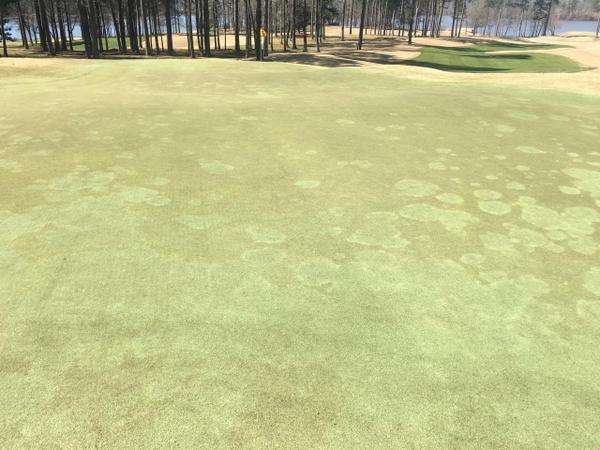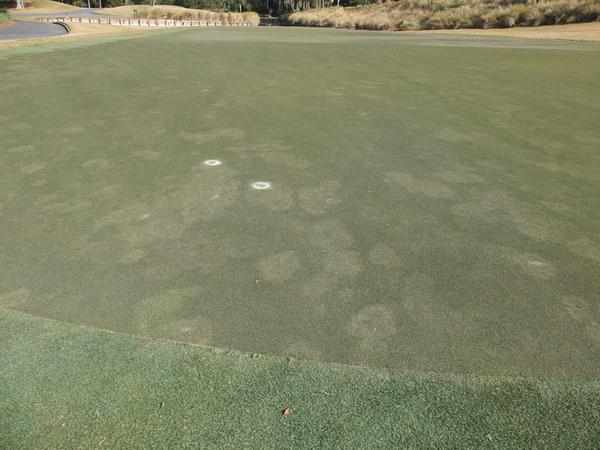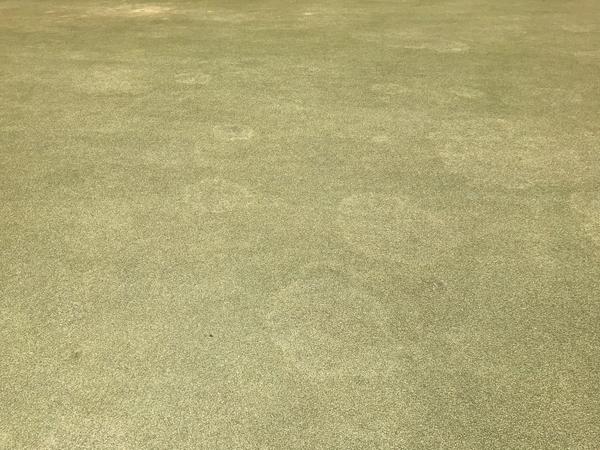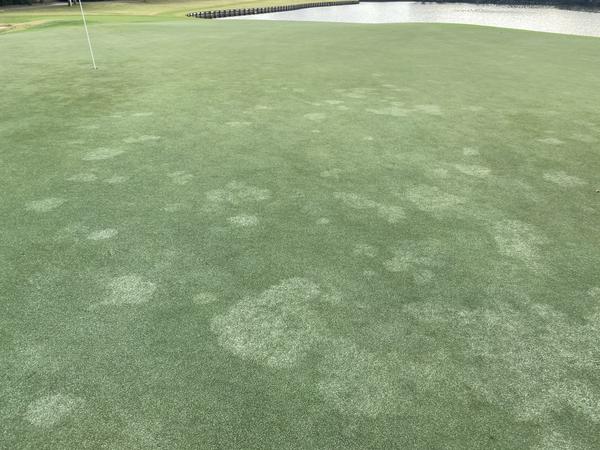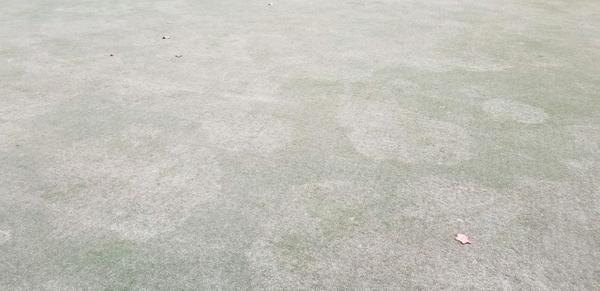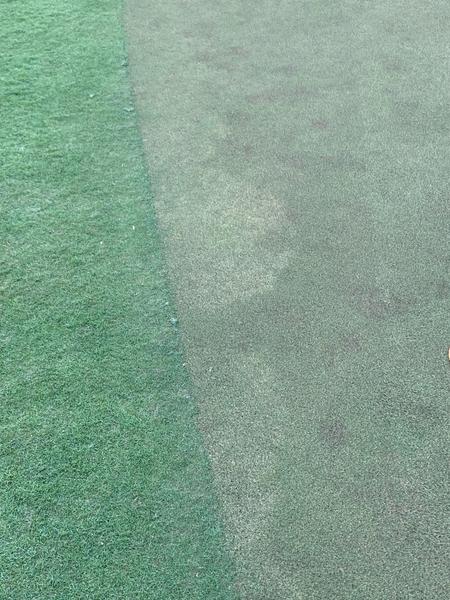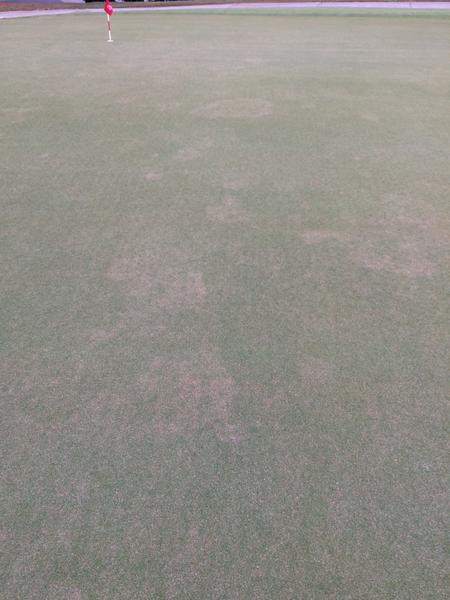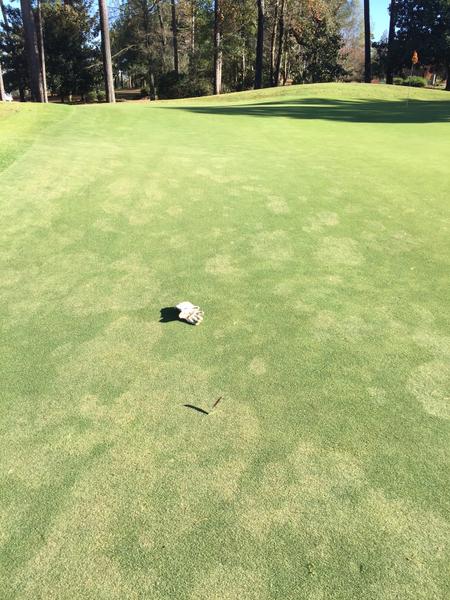Overview
Take-all root rot (TARR) is a disease of ultradwarf hybrid bermudagrass maintained at < 0.2” (5mm) for golf course putting greens. While typically observed on ultradwarf bermudagrass putting greens, other warm-season grasses are susceptible as well. Historically, Gaeumannomyces graminis was considered the primary causal agent of this disease (Elliott, 1991). However, recent research has associated multiple closely related organisms with take-all root rot (Martin, 2017; Vines et al. 2015). Historically, these pathogens were associated with bermudagrass decline or warm-season decline. Symptoms were typically observed during the summer months as irregular thinning, yet on ultradwarf bermudagrass, distinct patches appear fall through spring. Another notable difference are the roots emanating from nodes and stolons are necrotic. Symptoms of TARR are not exclusively associated with a poor growing environment (shade, poor drainage, high organic matter, etc.) like bermudagrass decline.
Symptoms
Stand symptoms of take-all root rot include irregular, off-color to white patches ranging from 4-48 inches in diameter. Turfgrass roots and stolons are necrotic. Darkly pigmented hyphae and hyphopodia (attachment and penetration structures) are common on affected roots and stolons. Disease severity may progress under high heat and increased stress to produce general thinning into non-distinct patches. Older leaves appear chlorotic and in severe cases necrosis at the plant crown is observed. Take-all root rot may also mimic root-knot nematode or Pythium root rot injury.
Development Factors
Recently, multiple organisms have been associated with take-all root rot. This has presented a challenge and opportunity for turfgrass pathologists to study the biology of the multiple pathogens associated with TARR. It is not uncommon to find these organisms present on healthy turfgrass and can be transported on sprigs. Like many diseases, changes in environmental conditions and plant health influence disease symptom development.
Most TARR samples sent to the Turf Diagnostics Lab are diagnosed in the fall, winter, and spring months. However, TARR is consistently diagnosed on a monthly basis throughout the year. The rise of TARR diagnosis in the shoulder seasons is likely due to the change in environmental conditions such as cooler and cloudy weather and shorter day length that increase bermudagrass stress. The optimal soil temperatures for the growth of TARR organisms ranges between 77-86°F (25-30°C) and preventative measures should be conducted during this time frame. Excessive thatch, poor drainage, over-irrigating, and stressed turfgrass are the most common factors contributing to TARR development. Other factors that may increase the severity of TARR are excessive low mowing heights, low fertility, and over regulation.
Cultural Control
Moisture and thatch management are important factors for TARR management. Therefore, limiting excessive moisture and poor drainage on golf course putting greens is critical. Aerification and light, frequent topdressing should be implemented to reduce thatch and organic matter accumulation. Avoid over regulation with plant growth regulators. Manganese has been shown to influence take-all of wheat (G. tritici) and take-all patch (G. avenae) in creeping bentgrass. While not extensively evaluated on TARR of bermudagrass (G. graminis and others), this practice may be beneficial for disease management. When stressful environmental conditions are prevalent for warm-season grasses (i.e. cool temperatures, excessive rain, cloudy weather) practices such as raising mowing height, decreasing mowing frequency by implementing lightweight rolling help alleviate plant stress.
Chemical Control
We are currently evaluating a number of different compounds in fungicide efficacy and application timing trials. While TARR-associated pathogens grow at a wide range of temperatures, symptom development in the Carolinas in the fall is most likely a result of infection when soil temperatures are between 77-86°F. Fortunately, many of the efficacious TARR fungicides work well on other warm-season diseases such as large patch, leaf spot, spring dead spot, and fairy ring. When targeting soil-borne diseases such as TARR, always follow the fungicide application immediately with at least 1/8” irrigation. TARR organisms are most sensitive to DMI and QoI fungicides and least sensitive to SDHI fungicides when evaluated in in vitro fungicide sensitivity assays. Applications of a phosphonate fungicide (Signature Xtra, Appear II) tank-mixed with chlorothalonil in conjuction with products listed in the table below is a robust fungicide program for TARR.
* Products marked with an asterisk are not labeled for home lawn use.
| Fungicide and Formulation1 | Amount of Formulation2 | Application Interval (Days)3 | Efficacy Rating | Resistance Risk | FRAC Code4 |
| azoxystrobin (Heritage) WG TL G |
0.4 2 2 to 4 lbs. |
28 28 28 |
+++ | Low | 11 |
| azoxystrobin + acibenzolar-S-methyl (Heritage Action)* | 0.4 | 28 | +++ | Low | 11/P01 |
| azoxystrobin + difenoconazole (Briskway)* | 0.5 to 1.2 | 14 to 28 | ++++ | Low | 11/3 |
| azoxystrobin + propiconazole (Headway) | 0.75 to 3 | 14 to 28 | ++++ | Low | 11/3 |
| azoxystrobin + propiconazole (Compendium) | 2.6 | 28 | ++++ | Low | 11/3 |
|
fluindapyr + flutriafol (Kalida) |
0.25 to 0.4 | 14 to 21 | +++ | Low | 7/3 |
| fluopyram + prothioconazole + propamocarb (Resilia)* | 4 | 14 to 28 | ++++ | Low | 7/3/28 |
| fluxapyroxad + pyraclostrobin (Lexicon) | 0.34 to 0.47 | 14 to 28 | +++ | Low | 7/11 |
| isofetamid + tebuconazole (Tekken)* | 3 | 14 to 28 | +++ | Low | 7/3 |
| mefentrifluconazole (Maxtima)* | 0.8 | 28 | +++ | Low | 3 |
| mefentrifluconazole + pyraclostrobin (Navicon)* | 0.7 to 0.85 | 14 to 28 | ++++ | Low | 3/11 |
| propiconazole (Banner MAXX) | 2 to 4 | 14 to 28 | +++ | Low | 3 |
|
prothioconazole (Densicor)* |
0.196 | 14 to 28 | +++ | Low | 3 |
|
pydiflumetofen + azoxystrobin + propiconazole (Posterity XT)* |
1.5 to 3 | 14 to 28 | ++++ | Low | 7/11/3 |
| pyraclostrobin (Insignia) | 0.7 | 14 to 28 | +++ | Low | 11 |
| tebuconazole (Torque)* (Mirage)* |
0.6 to 1.1 2 |
14 to 28 28 |
+++ +++ |
Low Low |
3 |
| triadimefon (Bayleton) | 1 to 2 | 21 to 28 | ++ | Low | 3 |
| trifloxystrobin + triadimefon (Tartan) | 2 | 28 | +++ | Low | 11/3 |
| 1 Other trade names with the same active ingredients are labeled for use on turfgrasses and can be used according to label directions. 2 Units are oz, fl oz, or lb depending on formulation. Apply fungicides in 2 to 5 gallons of water per 1,000 square feet according to label directions. Use lower rates for preventive and higher rates for curative applications. 3 Use shorter intervals when conditions are very favorable for disease. 4 Fungicide Resistance Action Committee code. Products with same code have the same mode of action and are in the same chemical class. * Products marked with an asterisk are not labeled for home lawn use. |
|||||
| Efficacy Rating ++++ = excellent control when conditions are highly favorable for disease development +++ = good control when disease pressure is high, excellent control when disease pressure is moderate ++ = good control when disease pressure is moderate, excellent control when disease pressure is low + = good control when disease pressure is low ? = not rated due to insufficient data |
|||||
| Resistance Risk Low = Rotate to different chemical class after 3-4 applications; tank mixing not necessary Medium = Rotate to different chemical class after 1-2 applications; tank-mixing with low or medium risk product recommended High = Rotate to different chemical class after EVERY application; tank-mix with low or medium risk product for EVERY application ? = not rated due to insufficient data |
|||||
Photos
-
Publication date: Dec. 16, 2019
Reviewed/Revised: Dec. 16, 2019
N.C. Cooperative Extension prohibits discrimination and harassment regardless of age, color, disability, family and marital status, gender identity, national origin, political beliefs, race, religion, sex (including pregnancy), sexual orientation and veteran status.

